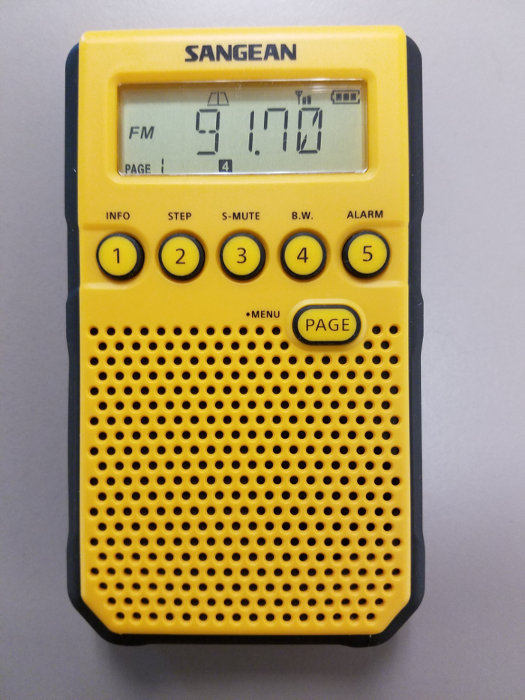
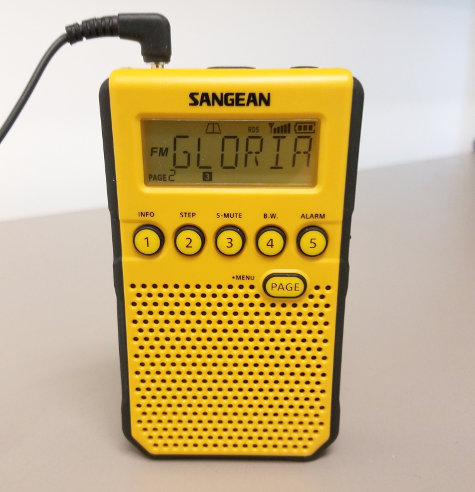
From left to right: Sangean DT-800 AM/FM/weather radio, displaying reception frequency (left) and Radio Data System (RDS) information from another station (right).
Clearly intended as the next-generation follow-up to the popular DT-400W model, the Sangean DT-800 packs a variety of features into a pocket-sized package, while leveraging digital signal processing (DSP) technology to offer a high level of performance.
The radio is available in either a yellow case or a "black" (really, dark gray) case. Because I have lots of black or dark-gray radios, I bought the yellow version. The list price for the DT-800 is about $100; I paid $60 plus tax for mine. At the time I wrote this review in January 2020, Amazon was charging between $55 and $57 (plus tax), with the dark gray unit being slightly cheaper!
The yellow case evokes the DT-400W, as does the inclusion of weather-band reception capability in the American version of the unit. The owner's manual indicates that there's also an international version that includes only AM and FM reception. The weather-radio band (162.4 through 162.55 MHz) is used only in North America.
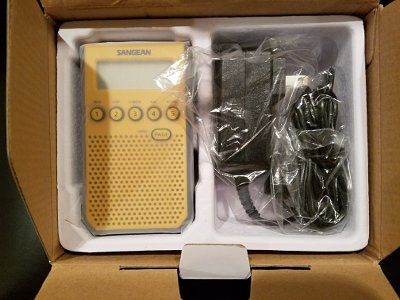
The radio comes attractively packaged and wrapped securely in a box (right). An AC adapter is included, as is a plug-in wire to serve as an FM and weather-band antenna. Earbuds also come with the package. The AC adapter terminates in a micro-USB plug, the same that's used on many smartphones.
High performance in a pocket-sized unit is not new: the CC Pocket is a pocket-sized DSP radio with excellent performance as well. The Sangean unit, though, brings together a number of features along with ergonomics that are well thought-out. Even with easy-to-use controls, this radio has a lot of features. As a consequence, it's important to read the user's manual, which clearly explains all the functions that are available. The manual includes sections in English, French, Spanish, Dutch, and German.
The most important control is on the front of the radio: the PAGE button which, when held down (or a long press), becomes the MENU button, which acts as a kind of shift key, affecting the five numbered memory positions, plus the tuning button on the right side of the unit.
As usual for Sangean radios, memory positions are organized in pages, with five storage locations per page. There are four pages each for AM and FM reception, giving a total of 20 memory storage locations in each band. There's an additional page for weather-band reception, which almost seems unnecessary, considering that there are only seven weather-band channels, but they're there if you want them.
The top of the unit features a headphone jack, a BAND button to cycle among the AM, FM, and weather-radio bands, and the power button. On the back of the unit, there is a switch that turns on the radio's "Dynamic Bass Boost" tone control, a feature common to many Sangean radios.
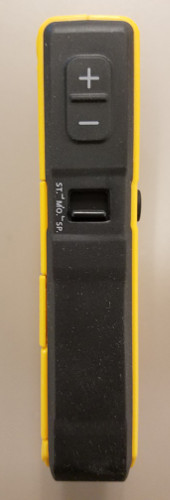
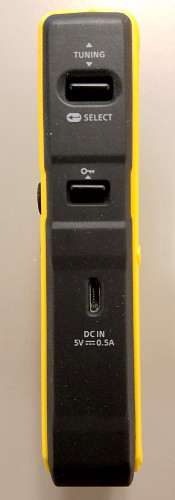
Most other audio-related controls are on the left side of the radio (shown at far left). The "plus" and "minus" keys control the volume. The switch below those buttons control whether the speaker is used or whether the headphone output is active. Headphone listening can be in stereo, if an FM stereo signal is available, or in mono. For speaker listening, a plug-in antenna wire is supplied for use in the FM and weather-radio bands.
As already mentioned, the PAGE/MENU button alters the operation of the memory buttons, as well as the tuning button, enabling access to more features of the DT-800. Starting with the front of the radio, the five memory-position buttons take on these roles after the MENU button is activated:
- Displays Radio Data System (RDS) information
- Sets the tuning steps between channels to enable faster or slower tuning
- Turns "soft mute" on or off
- Changes the frequency bandwith for AM and FM reception between wide and narrow settings
- Turns the alarm on or off
The tuning button on the right side of the radio (shown at near left) flips up or down to tune between channels. When the MENU button is activated, toggling the tuning button scrolls through a menu that's shown on the unit's display. Pushing in the button actually selects the menu item shown. Functions accessed through the menu include:
- BEEP: Turns the radio's "beep" on or off. Unlike other radios with a beeping function, this one beeps only when the MENU button is activated. It serves a useful function without being annoying, an excellent design decision by Sangean. Unlike all other radios that allow buttons to beep, I've actually left the BEEP function on for the DT-800!
- LIGHT: Selects how long the display backlight stays on after a button is pressed: 10 seconds or 20 seconds. You can also turn the backlight off altogether.
- ATS: Starts a dial scan with stations received being automatically stored in memory.
- AM 10K/9K: Sets the correct AM tuning step for your region: 10 kHz for the Americas; 9 kHz elsewhere.
- FM 100K, etc.: Sets the most convenient FM tuning step for your region, normally 200 kHz in the Americas; 100 kHz in most other locations; less commonly, 50 kHz.
- FM band frequency coverage: cycles through coverage that includes the FM band used in most of the world, the FM band in Japan, and both.
But, wait, that's not all that's on the menu!
- Display the firmware version
- Reset the radio's settings to factory defaults
- Set the alarm time
- Set the clock time
- Set the clock to display in either 12-hour or 24-hour time
- Set the time that the radio stays on, or turn off the automatic shutoff function altogether
Rounding out the controls on the right side of the DT-800, there is a lock switch that prevents the other radio controls from operating when switched on, and a micro-USB port for charging the batteries when rechargeable batteries are used.
The DT-800 requires 2 "AA" batteries. It's also capable of recharging nickel-metal hydride (NiMH) batteries. That function is switched off by default; a small switch in the battery compartment turns it on.
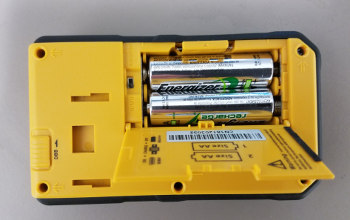
The battery compartment is slightly tricky to open: instead of pushing down on the latch, you need to press the latch toward the edge of the radio very quickly. The door should pop right open. This isn't explained well in the manual, and takes some practice to figure out. You don't need to worry about losing the battery compartment door. As is the case with most Sangean pocket radios, the door to the battery compartment is hinged and cannot come off the radio.
Tuning on the DT-800 is done either with presets or by pushing a recessed lever on the right side of the unit up or down. As mentioned earlier in this review, The DT-800's tuning steps can be set to 200 kHz (the North American standard) rather than 100 (used in the rest of the world). This can make tuning easier than on many other radios that use up and down buttons or similar methods for tuning. To maintain maximum compatibility worldwide, quite a few radios tune in 100 kHz increments on FM. This is less convenient compared to the DT-800, at least in North America.
Worldwide Version
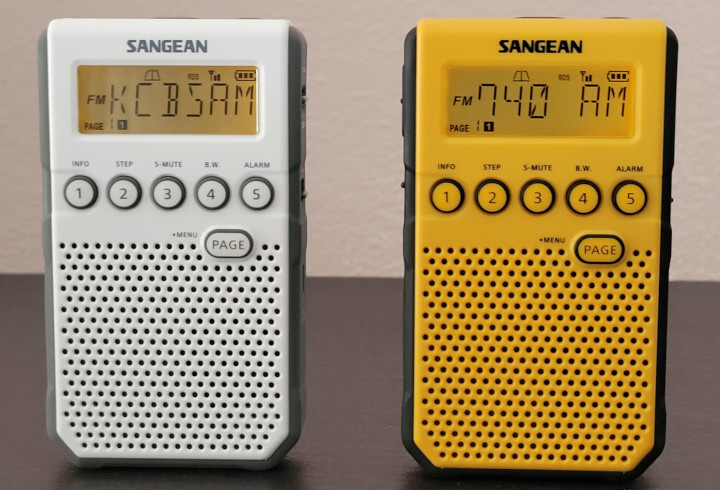
The DT-800 version that I first bought was the North American version. Later, I discovered that there was a version for the rest of the world, which I refer to here as the "worldwide" version. I purchased mine through Amazon France. It differs from the North American version in three ways.
- The worldwide version doesn't have a weather band, which is useful only in the United States and Canada anyway.
- The worldwide version has 50-microsecond de-emphasis for FM signals (a simple form of noise reduction) rather than the North American standard of 75 microseconds. North American FM stations can still be received on the worldwide version of the DT-800, but they will sound like a treble tone control has been turned up.
- The North American version comes in yellow or black while the worldwide version is available in white or black.
Otherwise, the two radios have identical features and performance.
Performance
With all the features in the DT-800, whether it's the North American version or the worldwide version, it's almost easy to forget about performance. The news in this regard is generally very good. I performed several head-to-head comparisons, generally with other pocket-size radios. I also compared the DT-800 to the earlier DT-400W pocket radio from Sangean.
First, on FM, there was no comparison with the DT-800's older brother: the DT-800 ran circles around the DT-400W. The DT-400W was moderately sensitive but not selective at all. Strong local stations could overwhelm weaker stations nestled between those stations on the dial. The DT-800 had no problem picking out many of those signals, whether in wideband or narrowband mode.
This comparison was with the older version of the DT-400W; the version I acquired in 2021 did not suffer from the deficiencies of the older model and was nearly equal to the DT-800 in performance. The DT-800 still seemed to be a little more refined.
Generally speaking, the DT-800's narrow bandwidth mode on FM made little difference in actual reception. There were occasional exceptions: lower-powered KDFC (90.3) and San Jose rimshot KJLV (97.7) could be received in stereo only in narrowband mode in one test, indicating a stronger signal than in wideband mode. But no additional FM stations were received by the DT-800 with the narrow FM bandwidth selected compared to the wide bandwidth setting.
Another test compared the DT-800 to the Sangean DT-160, which is also a DSP-based radio with two FM bandwidth settings. The two were very close performers on FM: sometimes the DT-160 was the only radio that got a particular station; other times, it was the DT-800 that was the winner. Natural variations in FM reception from minute to minute could have made the difference. So I'll call it a draw, and consider the DT-160 and DT-800 to be both very good in FM performance.
One more set of tests compared the DT-800 to a number of pocket and headphone radios. The full results are in the Vintage Sony Walkman Radios review; for convenience, here are the results for comparable DSP-based FM radios:
- Degen DE1123: 50 stations
- Tecsun PL-100: 46 stations
- CC Pocket (version 2): 47 stations
- Sangean DT-160: 44 stations (plus one in narrow bandwidth mode)
- Sangean DT-800: 46 stations
While the DT-800 wasn't the absolute best performer, it was up there. What was noticeable in this and other comparisons, though, were differences in FM stereo reception. Even when other radios such as the Degen DE1123 or the CC Pocket could get a reasonably clean, if occasionally noisy signal in stereo, the DT-800 (and the DT-160) would not switch to stereo reception, even though the radio had the ability to force mono reception. It seems that the DT-800 (and the DT-160) have a very high signal-strength threshold for FM stereo reception. When the unit is in stereo, the signal is nearly free of noise. But signals that might be weaker but still acceptable in stereo will only be received in mono on the Sangean units. This seems to be an odd design decision. That's why I've categorized the DT-800 and DT-160 as very good for FM reception rather than excellent.
I also performed a head-to-head comparison for weather band reception. Normally, six of the seven weather-band channels have stations in the San Francisco Bay Area. When I conducted this test, one station was out of service. The stations were:
- Channel 1 (162.400 MHz): San Mateo (strongest local signal)
- Channel 3 (162.450 MHz): Mount Umunhum (South Bay, for marine reports)
- Channel 4 (162.475 MHz): Sonoma County (North Bay)
- Channel 5 (162.500 MHz): San Rafael/Novato (North Bay)
- Channel 7 (162.550 MHz): Mount Umunhum (South Bay)
Channel 2 (162.425 MHz, Mount Diablo, Contra Costa County) was out of service at the time of this comparison.
The results of the comparison were surprising! Results are listed by channel number.
- Sangean DT-800: 1 (very good), 3 (poor), 4 (nothing) 5 (very good), 7 (fair).
- Sangean DT-400W (older version): 1 (excellent), 3 (fair), 4 (poor), 5 (excellent), 7 (very good)
- CC Pocket version 1: 1 (excellent), 3 (good), 4 (no), 5 (good), 7 (good)
- CC Pocket version 2: 1 (excellent), 3 (good), 4 (poor), 5 (good), 7 (good)
- CC Skywave: 1 (excellent), 3 (fair), 4 (good), 5 (good), 7 (fair)
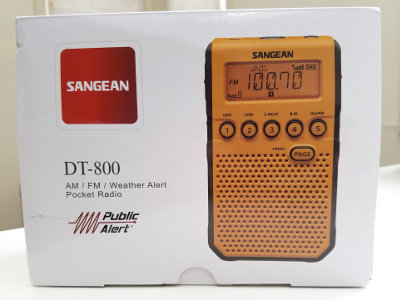
Conclusion
With these results, it's hard to reach a conclusion, but the good old Sangean DT-400W had the best overall performance, in my opinion. Even though the CC Skywave had the advantage of a dedicated antenna (the others used the headphone cord as the antenna), it mostly was an average performer except for that Sonoma County transmitter. In this case, DSP chips didn't offer an advantage over the DT-400W's venerable design!
For AM reception, the DT-800 was a very good performer, whether in wide or narrow bandwidth mode. Its performance was nearly identical to the CC Pocket (version 2) and the Sangean DT-160. Audio bandwidth settings were measured at approximately 3 kHz (wide mode) and 2 kHz (narrow mode), similar to the Sangean DT-160.
The DT-160 and DT-800 may well be using identical DSP chips and nearly identical supporting circuitry. The choice between them will come down to features. Most notably, the DT-800 has an RDS readout and a speaker; the DT-160 doesn't.
On the other hand, the CC Pocket (version 2) will be a better choice for headphone listeners to FM stations. It gets more stations in stereo than the DT-800, and still offers the option to force mono reception in areas where stereo reception gets too noisy. The CC Pocket has a wider AM audio bandwidth available: 4 kHz. In my opinion, this makes more pleasant listening than the 3 kHz bandwidth offered by the DT-800 in its "wideband" mode. The CC Pocket has slightly fewer features and can't recharge batteries, but listening capability is the most important feature of all, and there, the CC Pocket outshines the Sangean DT-800.